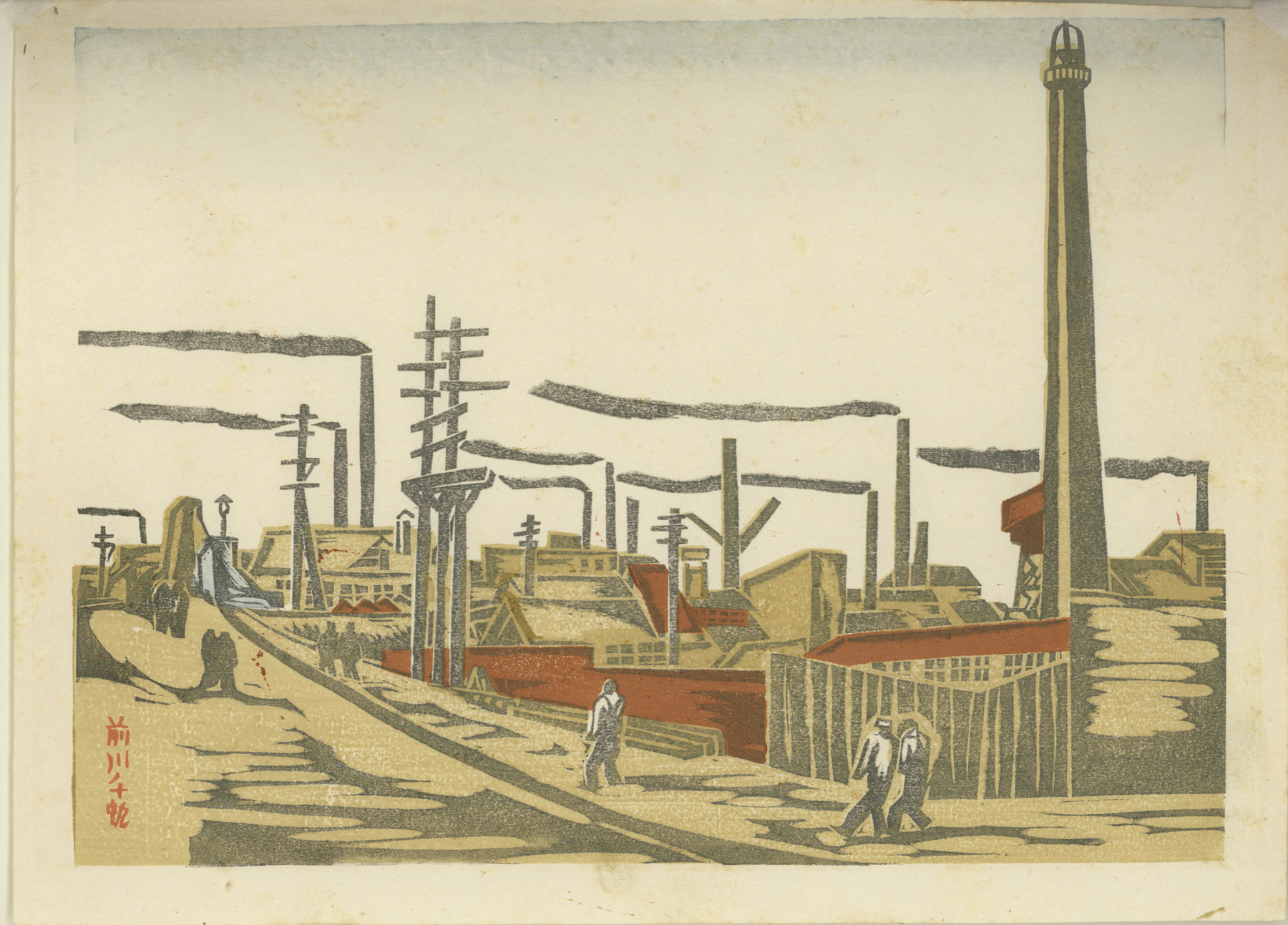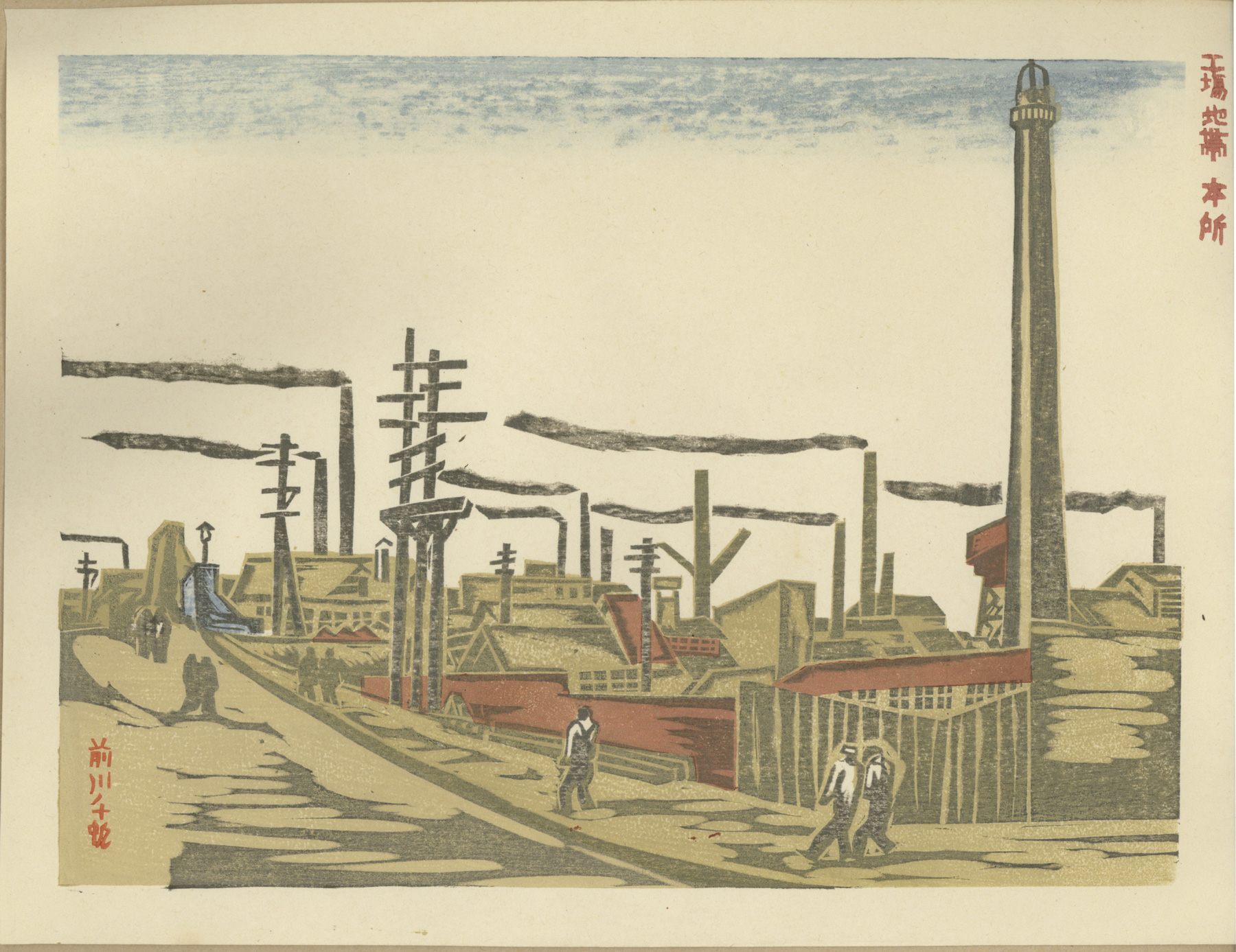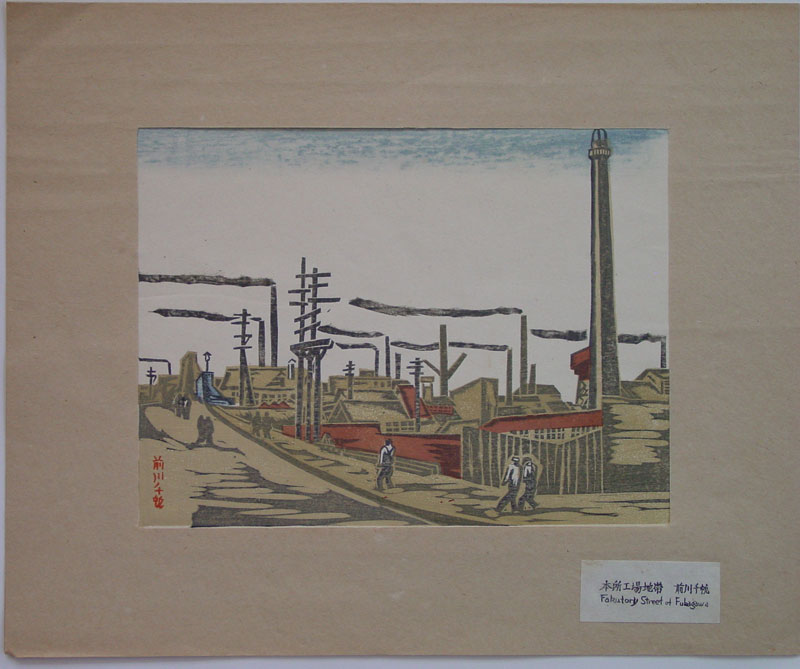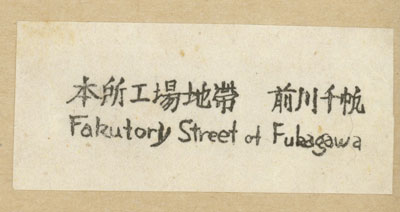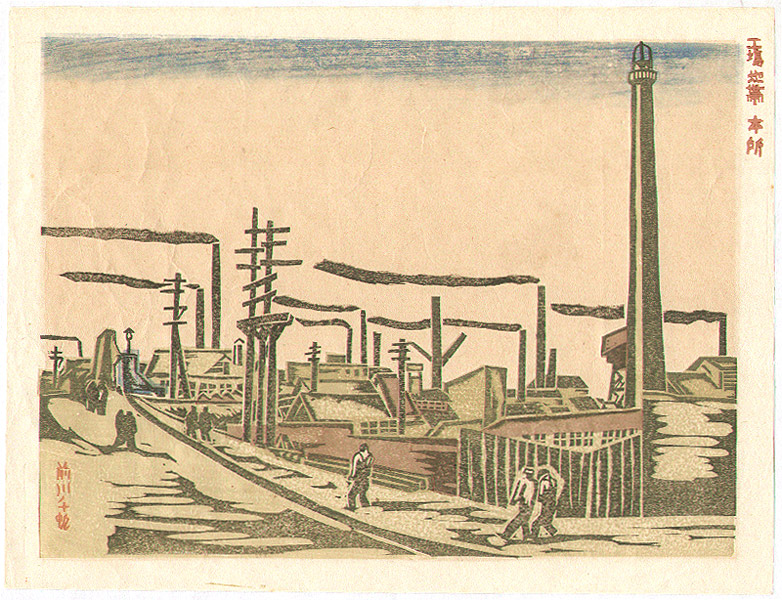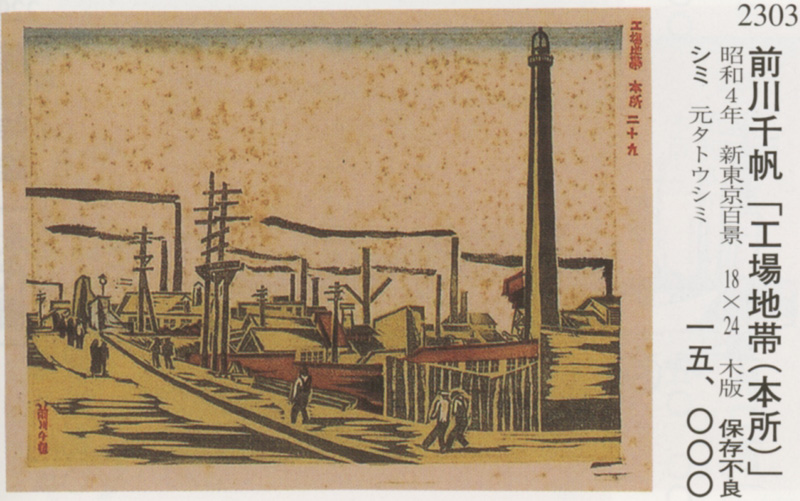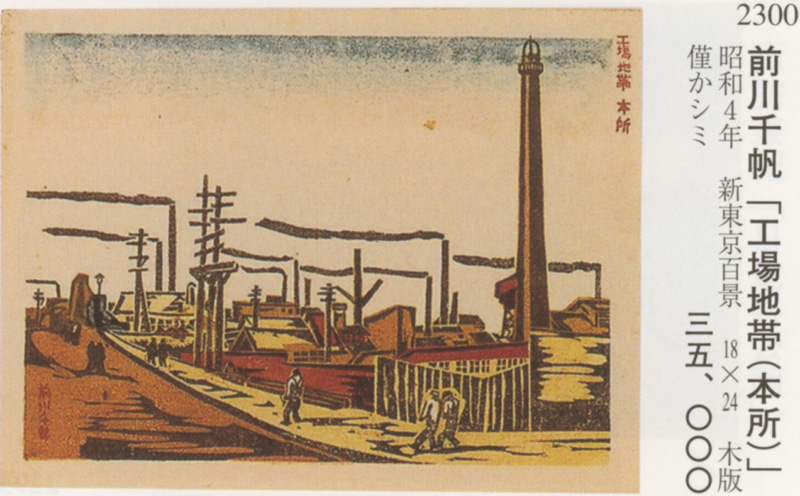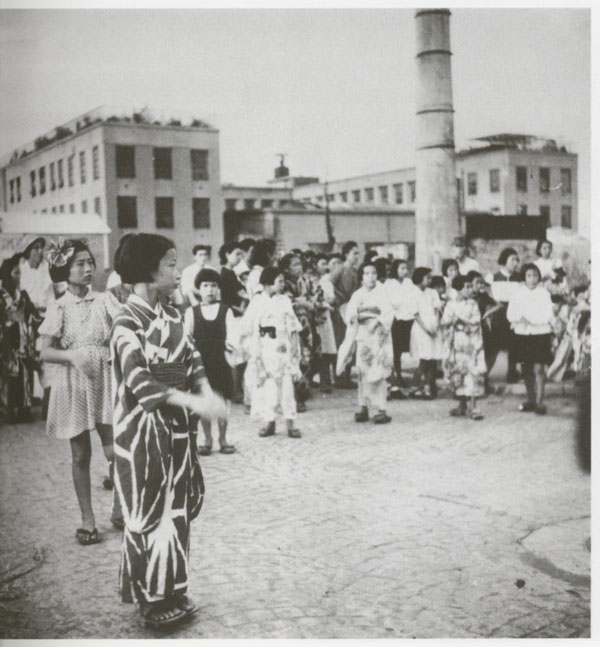About These Prints
This print was originally issued in 1929 with the title Factory Streets of Honjo (Kojochitai, Honjo) as part of the series One Hundred Views of the New Tokyo (Shin Tokyo Hyakkei) The print was re-issued in 1945 from newly cut blocks under the title Fakutory [sic] Street at Fukugawa for the series Scenes of Last Tokyo. IHL Cat. 56 and 174 are both 1945 re-issues, but represent two different states of this re-issue, as can be seen by the different treatment of the sky in the prints and the inclusion of the kanji characters in the upper right corner of IHL Cat. #174. According to some sources, the 1929 and 1945 issues can be distinguished by the presence of the kanji characters in the upper right margin, as seen in IHL Cat. #174. However, IHL Cat. #174 containing the kanji characters is definitely a 1945 issue, as it is tipped into a 1945 folio as shown below. Reference images for the 1929 issue are shown below.Source: Terrific Tokyo – A Panorama in Prints from the 1860s to the 1930s, Elizabeth de Sabato Swinton, Worcester Art Museum, 1998, p. 47.
Factory Streets at Honjo first appeared in One Hundred Views of the New Tokyo (Shin Tokyo Hyakkei), published between 1929 and 1932. This series captured the city that arose in the wake of the Great Kanto Earthquake of 1923. Published by the Takujo group, the series’ artists were all members of the Japan Creative Print Association. Immediately after World War II, Scenes of Last Tokyo, an album of fifteen prints, appeared. This print was one of the eight from the earlier series but was not printed from the original blocks but from new ones cut from the earlier prints. The print was re-titled in English Fakutory [sic] Street at Fukugawa for this 1945 series.
The artists had agreed to allow reissuing the prints for sale at the U.S. Army Post Exchange in Tokyo. Due to shortages after the war, the paper is quite different from that used for the originals, and the effect is consequently flatter and less vibrant than in the first state.
Honjo, east of the Sumida River, was designated as one of Tokyo’s industrial wards during the Meiji period. The writer Akutagawa Ryunosuke (1892-1927), who grew up in Hongo, described it in an essay written after the earthquake as “not the region of factories that it is today” but a city of ghosts. Situated across the river from Asakusa, it was after 1923 one of the poorest sections of the city. Maekawa catches the bleakness of this factory area, full of smokestacks and utility poles, with overall-clad factory workers trudging up the road. The seedily romantic quality of Akutagawa’s boyhood has been replaced by the harsh ugliness of industrialization.
Source: British Museum website http://www.britishmuseum.org/research/search_the_collection_database/search_object_details.aspx
This design was re-utilized from the original (1929) in the series One Hundred Views of New Tokyo (Shin Tokyo hyakkei). The blocks were re-cut, and there are many small differences of detail, but the more important difference is in the fresher colours, which rather ameliorate the sombre proletarian atmosphere of Maekawa's earlier version. In contrast to most of the views in this portfolio, this one had a genuine nostalgia, since this area of industrial Tokyo had been almost completely obliterated in the American air-raids (in Seidensticker, Edward, 'Tokyo Rising: The City Since the Great Earthquake', New York, 1990, it is stated that the population of Honjo fell to 4 per cent of its February 1944 population by June 1945(pp. 144-5)). Hacker's photograph of a street dance (below) shows industrial-type buildings of a similar style to those in this print.
Curator's comments
Smith 2002
This design was re-utilized from the original (1929) in the series One Hundred Views of New Tokyo (Shin Tokyo hyakkei). The blocks were re-cut, and there are many small differences of detail, but the more important difference is in the fresher colours, which rather ameliorate the sombre proletarian atmosphere of Maekawa's earlier version. In contrast to most of the views in this portfolio, this one had a genuine nostalgia, since this area of industrial Tokyo had been almost completely obliterated in the American air-raids (in Seidensticker, Edward, 'Tokyo Rising: The City Since the Great Earthquake', New York, 1990, it is stated that the population of Honjo fell to 4 per cent of its February 1944 population by June 1945(pp. 144-5)). Hacker's photograph of a street dance (below) shows industrial-type buildings of a similar style to those in this print.
Curator's comments
Smith 2002
| 本所工場地帯 前川千帆 Honjo factory zone Maekawa Senpan | |
| Print in folder with label as issued in 1945 (IHL Catalog #174) | 1945 folio label (IHL Catalog #174) |
Reference Images 1929 Issue
Maekawa Senpan, Industrial Area, Honjo (Kôjô Chitai, Honjo), 1929
from the series One Hundred Views of the New Tokyo (Shin Tokyo Hyakkei)
from the series One Hundred Views of the New Tokyo (Shin Tokyo Hyakkei)
Tokyo Street Dance, likely in Hongo district, c. 1945 by Ernst Hacker
Print Details
| IHL Catalog | #56 and #174 |
| Title | Factory Street at Fukagawa 工場?帯 本所 as printed in top right margin of IHL #174] and "Fakutory Street of Fukagawa” 本所工場地帯 (Honjo kōjō chitai) as labeled on print folder. |
| Series | Scenes of Last Tokyo [also seen translated as Recollections of Tokyo] 東京回顧図会 Tokyo kaiko zue |
| Artist | Maekawa Senpan (1888-1960) |
| Signature | Maekawa Senpan printed in Japanese in lower left corner of image |
| Seal | none |
| Publication Date | Originally published in May, 1929 as Honjo Factory District as part of the series Shin Tokyo Hyakkei (One Hundred Views of New Tokyo) and republished in 1945 from recut blocks |
| Edition | 1945 (both of these prints) |
| Publisher | Fugaku Shuppansha 富岳出版社, Tokyo, Uemura Masurō 上村益郎 publisher |
| Printer | Hirai Kōichi 平井孝一 |
| Impression | excellent |
| Colors | excellent |
| Condition | #56: good - numerous small foxing spots #174: excellent |
| Genre | sosaku-hanga (creative print) |
| Miscellaneous | |
| Format | chuban |
| H x W Paper | #56: 7 3/4 x 10 1/2 in. (19.7 x 26.7 cm); #174: 8 x 10 1/2 in. (20.3 x 26.7 cm) |
| H x W Image | #56: 7 x 9 1/2 in. (17.8 x 24.1 cm); #174: 7 x 9 1/2 in. (17.8 x 24.1 cm) |
| Collections This Print | Los Angeles County Museum of Art M.81.267.25; Museum of Fine Arts Boston 65.1087; Worcester Art Museum, Members’ Council Fund, 1987.79.10; The British Museum 1980,1227,0.18.14; Carnegie Museum of Art 89.28.977.2; Mead Art Museum at Amherst College 2008.63.14; Smithsonian Freer Gallery of Art and Arthur M. Sackler Gallery S1995.118.15; Portland Art Museum 1996.31.2n |
| Reference Literature | The Artist's Touch, The Craftsman's Hand: Three Centuries of Japanese Prints from the Portland Art Museum, Maribeth Graybill, Portland Art Museum, Oregon, 2011, p. 303; Terrific Tokyo A Panorama in Prints: from the 1860s to the 1930s, Elizabeth de Sabato Swinton, Worcester Art Museum. 1998 p. 47, pl. 16; Made in Japan – The Postwar Creative Print Movement, Alicia Volk, Milwaukee Art Museum, 2005, p. 35; Modern Japanese Prints: The Twentieth Century, Amanda T. Zehnder, Carnegie Museum of Art, 2009, p. 103 |


